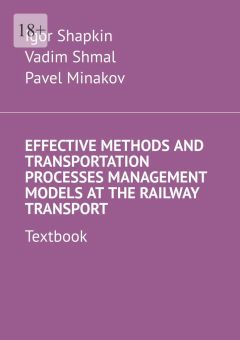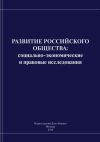Текст книги "Effective Methods and Transportation Processes Management Models at the Railway Transport. Textbook"

Автор книги: Igor Shapkin
Жанр: Прочая образовательная литература, Наука и Образование
Возрастные ограничения: +18
сообщить о неприемлемом содержимом
Текущая страница: 8 (всего у книги 11 страниц)
7 MODERN MANAGEMENT MODELS IN THE TRANSITION TO POLYGON TECHNOLOGIES
Russian Railways Holding is the largest backbone element of the Russian economy, the most important link in its transport system, carrying out more than 45% of cargo turnover and over 26% of passenger turnover of the entire transport system of the country.
It is one of the five largest companies in Russia, occupies a leading position in the world in the field of transport. Leadership in the domestic market of transport services and high technological competitiveness at the global level are ensured by a well-thought-out and effective strategy of scientific, technical and innovative development, primarily in the field of organizing the transportation process, as the foundation for the implementation of the Holding’s mission.
A strategic goal has been set: by improving the quality of services while maintaining a competitive cost of transportation, to significantly increase the share of transport and logistics services and become one of the five leading European companies in terms of logistics business.
Customer focus, the desire to improve transport services, and the achievement of global competitiveness in the transport and logistics market on their basis are defined as the values of the Holding. Achieving the goals is possible only on the basis of continuous improvement of the efficiency of the transportation process in all phases, scientific support for ways to improve the quality of services, increase labor productivity, and introduce innovative solutions.
The tools of the process approach make it possible to improve the efficiency of transportation, ensure an increase in the quality of services and achieve coordinated work of functional verticals and various divisions of Russian Railways and its subsidiaries and affiliates.
Transportation management can be decomposed into the main components: transportation planning, including the development of a plan for the formation and schedule of trains, the development of a variant schedule for performing work on the infrastructure, the rationing of operational performance indicators, the operational management of transportation work, the regulation of car and train traffic.
The transportation process accumulates all the sub-processes that provide and accompany the transportation of goods. The technology is largely determined by the infrastructure, as well as the established market model and the current regulatory framework. The technical equipment of stations and sections, traction facilities are at its core.
If we take into account the fact that our railways carry out mixed (freight, passenger, suburban and high-speed) traffic, and freight cars do not belong to the carrier (Russian Railways), then we can understand the complexity of organizing transportation.
Only on the basis of scientific methods, based on the principles of a systematic approach, it is possible to determine the scientific and practical directions of optimization, taking into account the optimal solutions in each of the phases of the transportation process. It develops under the influence of the requirements of participants in the transport services market, on the one hand, and decades of established technologies for the operation of railway transport, on the other.
In the unity and struggle of opposites, the evolutionary path of technology development takes place, which can be characterized as a path of continuous search for compromise solutions in the face of restrictions imposed by infrastructure, traction and regulatory framework.
However, all market participants are united by common goals: sales growth and efficiency improvement. Technologies should create opportunities for attracting additional cargo, competition, expanding the market for wagon and small shipments, and on the other hand, reducing operating costs by increasing the weight of trains, the productivity of locomotives and increasing the share of cargo transportation by departure routes and heavy trains, developing all elements of the technology of the transportation process and control systems.
Historically, the management system on the railways consisted of 4 levels: the central office – services in the departments – departments in the departments of the railways – railway stations. The subdivisions were in dual subordination: functionally to the transportation management department, and administratively to the heads of railways and departments. This led to contradictions in solving the strategic tasks of the company at the central level and tactical tasks at the regional level.
To eliminate them, a transition to a vertically integrated management structure was carried out. The establishment of the Central Directorate of Traffic Management and other structures in 2009 completed the transition to a three-tier train traffic control scheme by concentrating the dispatching apparatus in the control centers of regional directorates.
The development of the competitive sector in the field of operating freight cars required new solutions. The company has developed a Unified Network Technological Process (UNTP), and its discussion was also held within the framework of our Council. The necessary changes to the transport legislation were initiated. Some of them have already been reflected in various legal acts. However, the current economic conditions require the solution of new tasks to improve internal efficiency and maximize the use of available reserves.
The transition from a functional management structure to the construction of production cycles using the principles of the process approach makes it possible to eliminate losses existing at the junctions of roads, to ensure the consolidation of the work of all branches involved in transportation to fulfill the main quality indicators of work.
The technology that implements them can significantly increase the efficiency of the transportation process and speed up the delivery of goods.
The main tasks of management at the polygon level are the unified management of train flows and locomotives on long routes based on the traffic schedule; strengthening the interaction of marshalling yards on the basis of a train formation plan; execution of combined «windows» at the landfill in a single alignment; logistic interaction with seaports; effective management of local work, increasing the level of compliance with the standard terms of delivery of goods. Today, a polygon model for controlling locomotives has already been organized, the work of which is carried out on routes of several thousand kilometers under a single dispatch management.
An integral part of the development is the unification of traction rolling stock and its renewal at the expense of modern locomotives with improved characteristics. On this basis, increased unified standards for the weight of trains are introduced. The development of heavy traffic should be considered as the main alternative to increasing the size of the movement. At present, the solution of this problem has become possible through the use of cars with an increased axle load of 25 tf.
Science faces a number of major challenges. Scientists from our and other institutes are already actively working on their solution together with specialists from the Central Directorate of Traffic Management and Railways. In the first place is the task of determining the boundaries of polygons, the stages of the transition to the polygon management structure. This work is carried out by the department «Prospective development of the network and targeted programs». As a result, a final decision will be made to determine the boundaries of the landfills.
The main criterion for the formation of boundaries is the principle of achieving maximum effect on the basis of the concentration of freight and passenger traffic under a single management. A prerequisite is the development and standardization of indicators of its work, including not only voluminous, but also qualitative, characterizing the transportation process, transportation logistics, management of traction resources, organization of work and rest of locomotive crews and organization of repair work on infrastructure. The key principle of the landfill is the unification of the parameters of technology and infrastructure along its entire length, the elimination of existing contradictions at the borders of railways.
This will make it possible to organize the through passage of trains, minimize the number of technical operations along the route, reduce unproductive costs and increase carrying capacity. This implies systematic work (within the boundaries of the landfill) to regulate not only traction resources, but also car fleets, repair and modernize infrastructure «in alignment», and fulfill the traffic schedule.
The pilot project is the eastern landfill, which includes the Krasnoyarsk, East Siberian, Trans-Baikal and Far Eastern railways, which meets the developed criteria. Here, unified management should be ensured on the basis of the Transportation Process Control Center being created at the eastern range (MCC VP).
8 INTELLIGENT TRANSPORT SYSTEMS (ITS)
8.1The main ITS development directions
The national transport policy of many developed countries is currently based on the development and promotion of intelligent transport systems (ITS). They are considered as an effective means of solving the pressing problems of the transport industry, such as an unacceptable level of human losses as a result of transport accidents, delays in the turnover of passengers and goods, insufficiently high productivity of the transport system, increased energy consumption, negative impact on the environment, etc. In addition, ITS are an incentive for the development of a number of industries and new innovative technologies. The latter include technologies for creating intelligent control and monitoring systems, creating new transport systems and managing them, producing materials, creating energy-saving systems for transporting, distributing and consuming heat and electricity in the field of railway transport, processing, storing, transmitting and protecting information, producing software, reducing the risk and reducing the consequences of natural and man-made disasters, etc.
In Russia, a nationwide ITS program is being developed, which can become an effective tool for implementing the Transport Strategy of the Russian Federation for the period up to 2030. In the draft of this law, the intelligent transport system is defined as an integral part of the infrastructure of the transport complex, implementing the functions of automated management, information, accounting and control to meet the legal, financial, technological and information needs of participants in the transport process, as well as meeting the requirements of transport, information and economic security of society. As follows from this definition, it is planned to integrate modern information and communication technologies and automation tools into the transport infrastructure, vehicles in order to improve the safety and efficiency of transport processes. With regard to rail transport, the development of ITS is determined by such policy documents as the Strategy for the Development of Railway Transport in the Russian Federation for the period up to 2030.
8.2 Operational management intellectualization principles of the transportation process in railway transport
Management systems intellectualization implements a modern approach to information technology, which makes it possible to provide support for difficult-to-formalize tasks with incomplete, fuzzy and dynamically changing initial data. Of particular interest is the application of these systems in those subject areas where decisions are made on the basis of heuristics and conceptual models. The latter include an automatic system for controlling the operation of a marshalling yard with elements of artificial intelligence (ASUI).
A system can be considered intelligent if it implements the following basic functions:
1. Knowledge presentation and processing function. An intelligent system should be able to accumulate knowledge about the world around it, classify and evaluate it in terms of pragmatics and consistency, initiate the processes of obtaining new knowledge, correlate new knowledge with knowledge stored in the knowledge base. Here we are talking about accumulating the knowledge of expert specialists working at the marshalling yard, namely the operational dispatch personnel. The operational situation that arises during the implementation of the technological process, the task and the corresponding set of decisive rules and algorithms for making a set of control decisions.
2. Reasoning function. An intelligent system should be able to generate new knowledge with the help of logical inference and mechanisms for identifying patterns in accumulated knowledge, obtain generalized knowledge based on private knowledge and logically plan its activities.
3. Generalization function. An intelligent system should be able to communicate with a person in a language close to natural and receive information through channels similar to those used by a person when perceiving the world around him, be able to form «for himself» or at the request of a person explanations of his own activities, provide assistance to a person at the expense of knowledge that is stored in its memory and logical means of reasoning.
Within the framework of the functional model of the intelligent system, the following main elements should be identified in the design process:
– an intelligent interface that provides communication with the external environment and the transformation of information from external to internal and vice versa;
– inference subsystem based on the analysis of the semantics of input messages and available knowledge. It formulates the formulation of the problem, searches for options for its solution and chooses the best of them;
– a program generator that forms a solution program, using knowledge about the methods of solving specific problems to be solved;
– task interpreter that ensures the execution of generated programs;
– knowledge base. It provides storage and access to various types of knowledge used by an intelligent automated system in its operation.
The operation of the system under consideration at the marshalling yard is based on dynamic optimization models, in which control processes can be represented in the form of successive stages, at each of which a certain control decision is made. In some of them, the division into stages is natural, and in some it can be artificially introduced to simplify the solution of the problem. Such tasks have the following features:
– the decision-making process consists of N sequential steps;
– the state of the system at each step completely determines the results of decisions made in the future;
– at each step, one of the finite set of decisions is made;
– it is known what kind of change in the state of the system each decision will lead to.
The possibility of the operation of the automated control system necessitates the receipt in real time of a large amount of initial operational information, which is the initial data for modeling the technological processes occurring at the marshalling yard. Such information, for example, includes data on the location of mobile units at the station and adjacent sections, the state of the receiving, sorting and dispatch parks, the degree of readiness of trains for advancing on the marshalling yard, the technical condition and possible moments of failure of technical equipment in the control zone of the automated control system. Also here an important role is played by the «purity» of information flows, that is, the degree of their noise, which ultimately affects the formation of control commands and influences. To ensure these and other operational management purposes, the marshalling yard currently uses innovative technical means and automated systems for retrieving, storing and transmitting information.
The Luzhskaya railway station of the Oktyabrskaya Railway has become a testing ground for innovative technologies for the operation of marshalling yards, and the technical means introduced here are the basis for the formation of sparsely populated marshalling yard technologies for the future until 2025.
The following main technological operations are performed at the Luzhskaya station:
– acceptance of cargo for transportation, loading, unloading;
– organized reception, departure of trains according to the schedule;
– formation and disbandment of trains in accordance with the plan for the formation of trains;
– disbandment/formation of contractual dispatch routes in public places; technical and commercial inspection of wagons and elimination of detected malfunctions;
– disbandment / formation of shunting gears;
– work with local wagons arriving for unloading;
– processing of the site of current uncoupling repair of wagons;
– maintenance of non-public railway tracks;
– formation of ship parties (lashes) for «rolling» and delivery of transit cars to the ferry crossing for the route to Baltiysk, Kiel and Sassnitz.
To ensure the uninterrupted implementation of the considered technological operations, large-scale work is being carried out on the design and organization of an automated sorting complex within the framework of the automated transport hub control system (ATH CS) being created at the Luzhskaya station. At the same time, the following set of tasks is implemented:
– planning the arrival of goods at the station to a depth of up to 20 days;
– formation of an agreed plan for the supply of trains and the setting of ships for cargo operations for a period of up to 3 days;
– shift-daily and current planning of the work of the junction and station in cooperation with the DTCC and the road CIC;
– implementation of a dynamic model of the station’s operation, where data from automated systems are integrated;
– provision of real-time automatic control over the implementation of the main technological operations, as well as automation of the planning of the station and analysis of the results of the station and node;
– electronic document management.
Thus, the automated system for monitoring the car inventory numbers (ASMCIN) is designed to automatically read the numbers of cars, arriving or departing trains, recognize them, generate a certificate and transfer it to the station’s automated control system, where the recognition results are checked for compliance with a telegram – a full-scale sheet of the train, or other reference data.
The contents of the certificate include data of automated recognition of car numbers in accordance with their serial numbers in the train, information about the date and time of the train.
The ASMCIN system is recommended to be installed on the tracks of receiving/departing trains, in the marshalling yard of the station. The use of ASMCIN makes it possible to fully automate the process of reading car numbers, their recognition and transmission of the received data, improve working conditions and improve the quality of work of station personnel. At the marshalling yard, the Luga ASMCIN system is capable of providing:
– formation of video images containing inventory numbers of wagons;
– recognition of eight-digit inventory numbers of wagons based on generated video images;
– formation of a numbered list of train cars; color indication of unrecognized numbers;
– visual control by the operator of the correspondence of the recognized numbers to the video images of the inventory number;
– formation of reports on the accepted compositions; export of reports to enterprise information systems;
– round-the-clock work in any meteorological conditions.
The integration of this information system with the automated system for commercial inspection of trains and wagons (ASCI TV), the automated system for commercial inspection of rolling stock (ASCI RS) and the thermal imaging complex for remote control of wagon loading will make it possible to generate a whole segment of reliable operational data for primary processing and subsequent modeling of operational control actions in the automated infrastructure management system (AIMS).
Directly in the marshalling system of the Luzhskaya station, an innovative technology is being implemented for the dissolution of cars in the automatic control mode of the hump locomotive, which provides for the use of the MSR 32 slide automatic interlocking developed by Siemens AG, integrated with the Russian automated control system of the marshalling yard, in conjunction with domestic interlocking systems and the shunting automatic locomotive signaling system.
Beam car retarders manufactured by SONA are used as retarders at all braking positions of the marshalling yard. At the first two brake positions, two retarders of the TW-4F type are installed in series, at the provided six second brake positions, two retarders of the TW-4F type are installed in series.
The provided 6 beams of tracks (6 sorting / 8 sorting / 8 sorting / 8 sorting / 8 sorting / 6 sorting) are equipped with retarders of the third braking position of the TW-5EF type, which operate on the principle of aimed braking.
Two beams (8 marshalling yards / 8 marshalling tracks) are equipped with pull-up devices. To determine the free length of the run, each sorting track, equipped with a retarder of the third braking position, is equipped with 2 measuring sections for monitoring the filling of the track. Marshalling yards equipped with pull-up devices also have a track filling control system. The route management system was automated, as well as the control system for the retarders of the first, second and third brake positions of the marshalling yard and the control system for pull-up devices.
To achieve optimal system performance, it is possible to determine the thrust velocity using operational simulation. The speed values are displayed on the graphical user interface of the hill attendant and transmitted to the hump locomotive.
The dissolution process control system takes over the entire control task in the entire dissolution area between the slide and the marshalling tracks. To perform all these tasks, the system is equipped with a route management system that manages turnouts in this area based on data from full-scale sheets in the process of automatic dissolution. To control the speeds, an automatic control system for the retarders of the first, second and third positions is provided. The control systems of the retarders of the first and second positions ensure that the distance of the uncouplings from each other is respected so that the arrows in the distribution area can be reliably transferred between the detachments. In addition, the speeds are calculated in such a way as to take into account the performance of the individual retarder. The retarders of the third braking position will be controlled by the method of targeted braking, depending on the filling of the individual marshalling tracks.
For shunting movements in the entire zone, it is possible to establish shunting routes. The system monitors and controls all arrows and signals located inside the zone, as well as all dwarf traffic lights located on the border of the zone and pointing in its direction. This also applies to the slide traffic lights on the slide.
When implementing the program of integrated automation of sorting processes at the Luzhskaya station, requirements are imposed on the probability of damage to cars during dissolution from the hill at a level of no more than 10—6, the processing capacity of the hill is more than 5 thousand cars per day, a reduction in the cost of processing one car by 5%, as well as an increase in the labor productivity of employees of the mining complex, including employees of the automation and telemechanic economy, engaged in the maintenance of microprocessor equipment and low-maintenance floor equipment, reducing by a quarter the volume of consumed electric power resources.
Automated systems for diagnostics of rolling stock and commercial inspection are being put into operation at the station, which provide a significant reduction in the need for staff at points of technical and commercial inspection of cars, and unmanned technology for securing rolling stock is being introduced.
For the effective functioning of the considered AIMS, the technical means used at the marshalling yard in the implementation of the presented information technology must meet the following requirements:
– providing solutions to problems in real or close to it in time;
– ensuring the possibility of building multi-machine complexes (when they are organized) on models of different performance;
– ensuring high reliability;
– ensuring effective human interaction with the system.
The considered technical means are the executive bodies to which control actions are applied from the automatic control system of the marshalling yard with elements of artificial intelligence.
The construction of an automatic control system with elements of artificial intelligence at network marshalling yards, which will provide an opportunity to timely and efficiently transfer the necessary arrays of information resources to adjacent information and control systems, which is able to perceive and implement the control actions received from them, will ultimately ensure the efficient and uninterrupted implementation of the technological process of operation of any marshalling yard of JSC Russian Railways.
Правообладателям!
Это произведение, предположительно, находится в статусе 'public domain'. Если это не так и размещение материала нарушает чьи-либо права, то сообщите нам об этом.








































